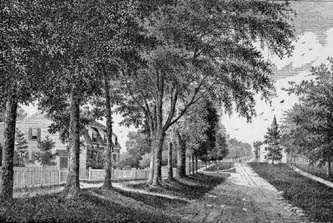|
Norwalk River
The Norwalk River is a river in southwestern Connecticut, United States, approximately long.U.S. Geological Survey. National Hydrography Dataset high-resolution flowline dataThe National Map accessed April 1, 2011 The word "Norwalk" comes from the Algonquian word "noyank" meaning "point of land". Description The Norwalk River originates in ponds located in Ridgefield, Connecticut. These ponds empty into Ridgefield’s approximately "Great Swamp". The river continues through Ridgefield, and is augmented by the "Great Pond" ( above sea level), one of the purest lakes in Connecticut due to its being fed by underwater springs. The river is closely paralleled by U.S. Route 7 as it flows southward through Branchville, Georgetown, Wilton, and Norwalk, where it is joined by the Silvermine River and then flows into Norwalk Harbor and finally into Long Island Sound. Recreational fishing continues to be a popular sport along the course of the river, in addition to oystering at th ... [...More Info...] [...Related Items...] OR: [Wikipedia] [Google] [Baidu] |
Ridgefield, Connecticut
Ridgefield is a town in Fairfield County, Connecticut Connecticut () is the southernmost state in the New England region of the Northeastern United States. It is bordered by Rhode Island to the east, Massachusetts to the north, New York to the west, and Long Island Sound to the south. Its cap ..., United States. Situated in the foothills of the Berkshire Mountains, the 300-year-old community had a population of 25,033 at the 2020 United States Census, 2020 census. The Ridgefield (CDP), Connecticut, town center, which was formerly a borough (Connecticut), borough, is defined by the U.S. Census Bureau as a census-designated place. History Ridgefield was first settled by English colonists from Norwalk, Connecticut, Norwalk and Milford, Connecticut, Milford in 1708, when a group of settlers purchased land from Chief Katonah, Chief Catoonah of the Ramapough Mountain Indians, Ramapo tribe. The town was incorporated under a royal charter from the Connecticut General Assembly ... [...More Info...] [...Related Items...] OR: [Wikipedia] [Google] [Baidu] |
Angling
Angling is a fishing technique that uses a fish hook or "angle" (from Old English ''angol'') attached to a fishing line to tether individual fish in the mouth. The fishing line is usually manipulated via a fishing rod, although rodless techniques such as handlining and longlining also exist. Modern angling rods are usually fitted with a reel that functions as a cranking device for storing, retrieving and releasing out the line, although Tenkara fishing and cane pole fishing are two rod-angling methods that do not use any reel. The hook itself can be additionally weighted with a dense tackle called a sinker, and is typically dressed with an appetizing bait to attract the fish and enticing it into swallowing the hook, but sometimes an inedible fake bait with multiple attached hooks (known as a lure) is used instead of a single hook with edible bait. A bite indicator, such as a float or a quiver tip, is often used to relay underwater status of the hook to the surface. When ... [...More Info...] [...Related Items...] OR: [Wikipedia] [Google] [Baidu] |
Connecticut Placenames Of Native American Origin
Connecticut () is the southernmost state in the New England region of the Northeastern United States. It is bordered by Rhode Island to the east, Massachusetts to the north, New York to the west, and Long Island Sound to the south. Its capital is Hartford and its most populous city is Bridgeport. Historically the state is part of New England as well as the tri-state area with New York and New Jersey. The state is named for the Connecticut River which approximately bisects the state. The word "Connecticut" is derived from various anglicized spellings of "Quinnetuket”, a Mohegan-Pequot word for "long tidal river". Connecticut's first European settlers were Dutchmen who established a small, short-lived settlement called House of Hope in Hartford at the confluence of the Park and Connecticut Rivers. Half of Connecticut was initially claimed by the Dutch colony New Netherland, which included much of the land between the Connecticut and Delaware Rivers, although the first major ... [...More Info...] [...Related Items...] OR: [Wikipedia] [Google] [Baidu] |
Rivers Of Fairfield County, Connecticut
A river is a natural flowing watercourse, usually freshwater, flowing towards an ocean, sea, lake or another river. In some cases, a river flows into the ground and becomes dry at the end of its course without reaching another body of water. Small rivers can be referred to using names such as creek, brook, rivulet, and rill. There are no official definitions for the generic term river as applied to geographic features, although in some countries or communities a stream is defined by its size. Many names for small rivers are specific to geographic location; examples are "run" in some parts of the United States, "burn" in Scotland and northeast England, and "beck" in northern England. Sometimes a river is defined as being larger than a creek, but not always: the language is vague. Rivers are part of the water cycle. Water generally collects in a river from precipitation through a drainage basin from surface runoff and other sources such as groundwater recharge, springs, a ... [...More Info...] [...Related Items...] OR: [Wikipedia] [Google] [Baidu] |



